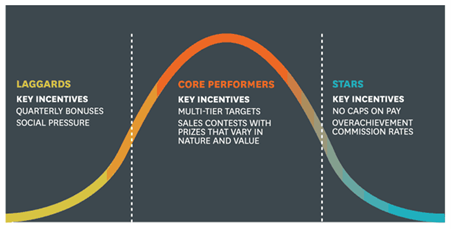Incentive schemes are one of the most effective means of increasing sales and engaging employees. Here at Cosine, we have huge expertise that can help accelerate your sales performance.
What makes sales incentives motivating, and a driver to accelerate performance?
When establishing an incentive scheme for your team, there are multiple factors to consider in determining the most effective construct. We always begin the process by asking some questions to ensure that there is the right sales incentive scheme.
How do you reward your top performers for the exceptional work they do?
How do you keep your team focused on their target each week?
How do you offer your mid-low performers an aspirational target for their sales delivery?
How do you tap into the mindset of a salesperson to unlock the desire to go from 'delivering' to 'over-delivering'?
The incentive put in place must inspire the salesperson to continually push themselves to deliver and exceed their goals, plus maintain a high degree of engagement with their role. A study by the Incentive Research Foundation identified several key findings in relation to incentive schemes:
- If correctly created and implemented, incentive schemes can increase performance by an average of 22%.
- Incentive programmes increase interest at work, and when asked to persist towards a goal, performance increases of up to 27% can be seen.
- Incentive programs work best when certain key criteria are met:
- Cause of under-performance is lack of motivation
- Desired goals are quantifiable
- The goals are challenging but achievable
- The desired behaviours align with strategic organisational goals
The above demonstrates that a well thought out and correctly implemented incentive scheme can result in a tangible increase in performance.
Motivation
Key to the development of an incentive scheme is gaining a deeper understanding of what motivates the individuals within a team to succeed. Understanding the goals and aspirations of the individuals will support the creation and implementation of the scheme by aligning the potential outcomes to those goals and aspirations.
A potential barrier to this presents itself as the size of the team increases. As the individual goals become greater and more diverse it can be difficult to continually align the outcomes to those goals, a result of which is then a requirement to understand the broader characteristics of those aspirations. In a sales environment, whether explicitly stated or not, and regardless of where the individual ranks it within their list, there is almost always a financial element to the individuals’ goals.
Performance
The influence of an incentive on accelerating performance can depend heavily on where the salesperson sits in terms of the overall team performance. Usually, they will sit within one of 3 categories – Stars, Core Performers and Laggards (these are terms referred to and used by the Harvard Business Review). How an incentive is built and targeted will appeal differently to each of these groups, e.g., a volume-based incentive is unlikely to appeal to the laggards, as they will see they are unlikely to win and therefore will disengage immediately from the incentive. Harvard Business Review analysed what types of incentives appeal to the different groups:

Case Study – A Cosine sales team in the finance sector
Our Challenge:
Our sales team were incentivised to deliver their sales target based on a value for each individual sale, but there was no system in place to encourage them to over-deliver against their targets. Subsequently, we often found ourselves in situations whereby each week would start strong, with the team closing their pipeline deals for the week early, then starting to build their pipeline for the following week. If the opportunity to over-deliver against their target presented itself, they would often hold back converting the sale until the following week, maintain their pipeline and work gradually through their territory. As a result, we were consistently struggling to reach our national target on a regular basis, so we needed to look at changing the way we rewarded our people to meet our targets.
Trial and Error:
We explored options that were collective (i.e., team -based rewards) and individual-based rewards, as well as exploring different timeframes for the different remuneration options. This trial gave us an indicator of which elements of the different approaches would work for our team. As people that are field based, working in their own territory with primarily only virtual interaction with their team-mates, we discovered that team-based incentives did not illicit the response we needed. We also established that short, sharp incentives worked well for those with a strong pipeline but didn’t impact across the 3 groups. Similarly, longer time periods for incentives led to disengagement from all but the very top performers.
The Solution:
Taking the key learnings from the trials we created an incentive scheme which ran on a weekly basis, rewarding those in the left “half” of the bell curve above for achieving the targets they had previously been missing, whilst giving our stars the opportunity to boost their earning potential by up to 60% per week.
Since introducing the scheme, we have seen performance increase by over 20%, and the number of team members working at or above their targets is at the highest level we have seen since 2020.
Key Learnings:
Our construction and implementation of the incentive scheme aligned with the research by the Incentive Research Foundation:
- Cause of under-performance is lack of motivation
In the case study above, there was not less of a lack of motivation, but there was little in place to generate sufficient motivation to go “above and beyond” for the better performers.
- Desired goals are quantifiable
The goals we set we clear and easy to understand and gave the team specific quantifiable targets to work with.
- The goals are challenging but achievable
The stretch targets in place push the team to try to deliver up to 200% of the weekly target, but we have consistently seen a variety of team members deliver those stretch targets.
- The desired behaviours align with strategic organisational goals
The goals aligned with our strategic target of delivering our annual sales target and provide the opportunity for both the salespeople and the sales managers to continually push above and beyond the weekly sales targets.
Cosine is leading a sales agency, experts in exceeding sales targets for our clients. If you would like to discuss how to improve your sales numbers through outsourcing, please contact us
Blog Author Richard Pomeroy
